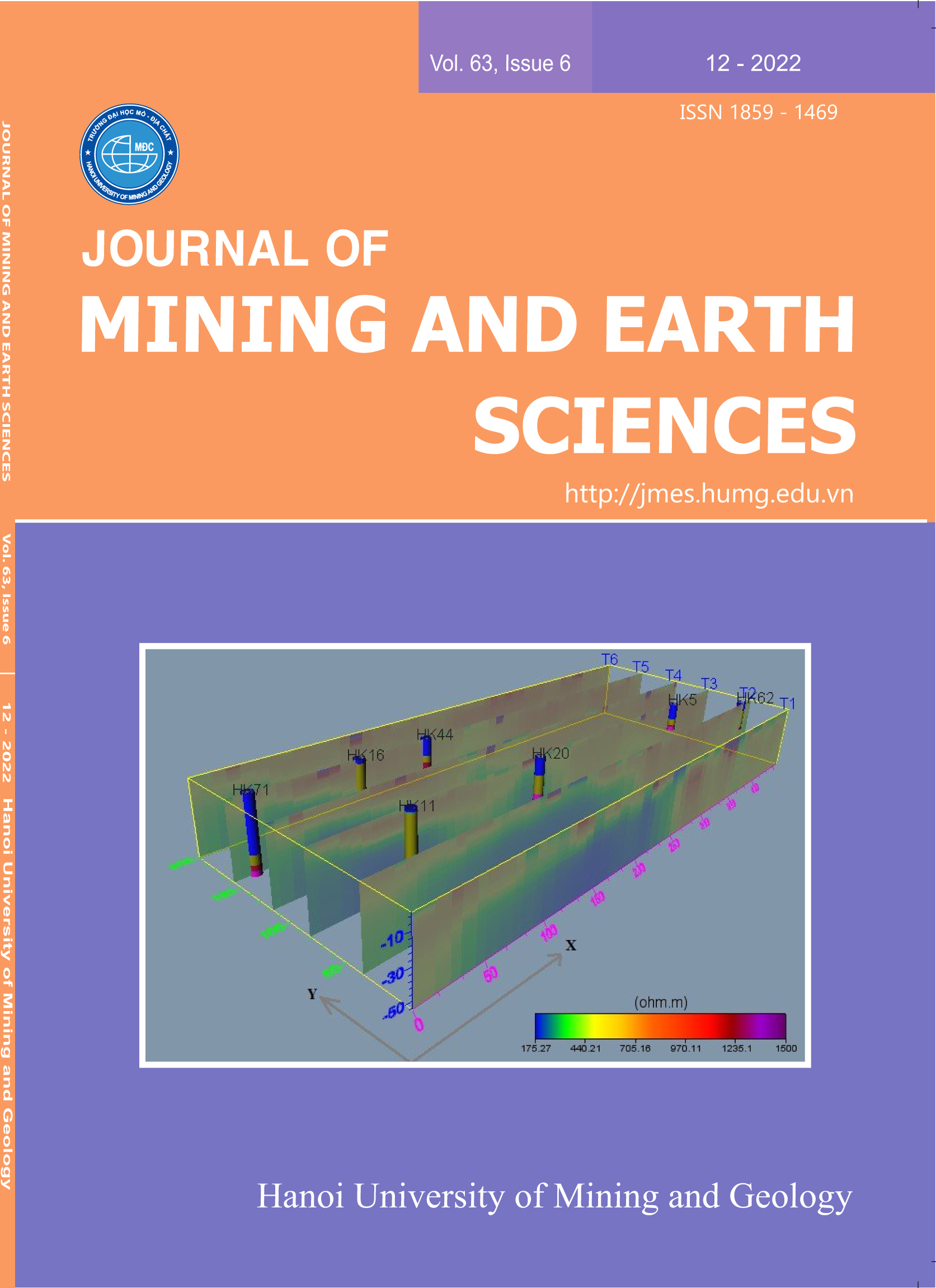Longwall top coal fall index from an integrated numerical and statistical analysis
Tóm tắt
Assessment of top coal fall potential is of great importance for sustainable longwall caving mining. However, available assessment tools/indices for the fall are applicable to roof rock only, and their use for top coal (whose geological structures may be different) can be inappropriate. This paper presents a new index for top coal fall in longwall mining where the fall is controlled by the cantilever effect. The index is developed from an integrated numerical and statistical analysis using the database from Ha Lam coal mine in Vietnam. The numerical analysis reveals that the strength and stiffness of in-seam discrete fractures and coal’s elastic modulus are inversely proportional to top coal fall. Meanwhile, the density of discrete fractures and seam depth are found to be directly proportional to the fall. A procedure for the development of assessment equation for top coal is established using single and multiple regressions and model transformation technique. A new assessment index for longwall top coal fall named Fall Index (FI) is proposed, taking coal elastic modulus, fracture density, fracture friction angle, fracture stiffness and seam depth as input parameters. The study also reveals that statistically seam depth has the most significant effect while fracture density and fracture strength show the least significant effect on top coal fall. At the same time, coal’s elastic modulus and fracture stiffness play similar roles in the fall. The results from this paper assist engineers in better assessing top coal fall potential and subsequently better controlling longwall stability for various geological conditions in mine design.Tài liệu tham khảo
Calleja, J. (2008). CMRR-Practical Limitations and Solutions. Coal Operators' Conference. University of Wollongong. The Australasian Institute of Mining and Metallurgy, 92-103.
Frith, R. (2005). Half a career trying to understand why the roof along the longwall face falls in from time to time? 24th International Conference on Ground Control in Mining. West Virginia University, 33-43.
Guo, W., Liu, C., Dong, G., & Lv, W. (2019). Analytical study to estimate rib spalling extent and support requirements in thick seam mining. Arabian Journal of Geosciences, 12, 276.
Hoyer, D.I. (2011). Early warning of longwall weighting events and roof cavities using LVA software. International Conference on Ground Control in Mining. Morgantown. West Virginia University, 207-213.
Iannacchione, A., Prosser, L., Esterhuizen, G. & Bajpayee, T. (2007). Methods for determining roof fall risk in underground mines. Mining Engineering, 59, 47-53.
Islavath, S.R., Deb, D. & Kumar, H. (2020). Development of a roof-to-floor convergence index for longwall face using combined finite element modelling and statistical approach. International Journal of Rock Mechanics and Mining Sciences, 127, 104221.
Itasca Consulting Group. (2019). UDEC – Universal Distinct Element Code, Ver. 7.0. Minneapolis: Itasca.
Kong, D., Liu, Y., Zheng, S. & Han, C. (2019). The Coal Face Failure Controlling Mechanism and Parameter Optimization of ‘Manila + Grouting’ Technology in a Large-Cutting-Height Panel. Geotechnical and Geological Engineering, 38, 755-765.
Kutner, M.H., Nachtsheim, C.J., Neter, J. & Li, W. (2005). Applied linear statistical models.Mass., McGraw-Hill Irwin. Boston.
Langosch, U., Ruppel, U., & Witthaus, H. (2003). Longwall roof fall prediction and shield support recommendations. 22nd International Conference on Ground Control in Mining. Morgantown, WV, 27-32.
Le, T.D., Bui, M.T., Pham, D.H., Vu, T.T. & Dao, V.C. (2018). A modelling technique for top coal fall ahead of face support in mechanised longwall using Discrete Element Method. Journal of Mining and Earth Sciences, 59, 56-65.
Le, T.D., Dao, H.Q. & Vu, D.H. (2022). Impact of
discrete fracture characteristics on longwall top coal stability. Acta Montanistica Slovaca, 27(4). (accepted).
Le, T.D., & Oh, J. (2022). Longwall face stability analysis from a discontinuum-Discrete Fracture Network modelling. Tunnelling and Underground Space Technology, 124, 104480.
Le, T.D., Vu, D.H. & Nguyen, A.T. (2020). Characteristics of top coal fall in front of face support in longwall: A case study. Vietnam Journal of Earth Sciences, 42, 152-161.
Małkowski, P., & Juszyński, D. (2021). Roof fall hazard assessment with the use of artificial neural network. International Journal of Rock Mechanics and Mining Sciences, 143, 104701.
Medhurst, T., Hatherly, P., & Hoyer, D. (2014). Investigation of the relationship between strata characteristics and longwall caving behavior. 14th Coal Operators' Conference. University of Wollongong. The Australasian Institute of Mining and Metallurgy & Mine Managers Association of Australia, 51-62.
Mitchell, G.W. (2009). Longwall mining. Australasian coal mining practice. 3rd ed. Australasian Institute of Mining and Metallurgy.
Mohutsiwa, M., & Musingwini, C. (2015). Parametric estimation of capital costs for establishing a coal mine: South Africa case study. Journal of the Southern African Institute of Mining and Metallurgy, 115, 789-797.
Prusek, S., Rajwa, S., Wrana, A. & Krzemień, A. (2017). Assessment of roof fall risk in longwall coal mines. International Journal of Mining, Reclamation and Environment, 31, 558-574.
Ryan, T.P. (2008). Modern Regression Methods, John Wiley & Sons, Inc.
Trueman, R., & Hutchinson, I. (2018). The use of shield monitoring data for predicting in advance roof control problems on longwall faces. Mining Technology, 127, 209-218.
Yao, Q., Li, X., Sun, B., Ju, M., Chen, T., Zhou, J., Liang, S. & Qu, Q. (2017). Numerical investigation of the effects of coal seam dip angle on coal wall stability. International Journal of Rock Mechanics and Mining Sciences, 100, 298-309.


